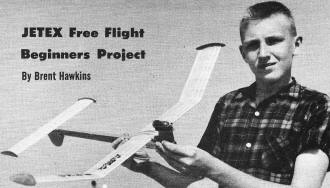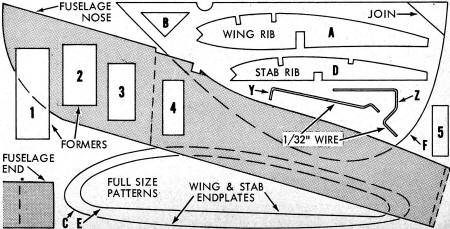|
Jetex engines enjoyed wide
popularity in the 1950s and 60s, even into the 1970s. Unlike using a model rocket engine for
propulsion which produces a short duration of high thrust, Jetex engines were a relatively long burning, low thrust propulsion source.
Rather than launching a model vertically at great initial velocity, the Jetex engine allowed a mode
to be launched my hand in a slightly nose high attitude and the model would gradually build speed
for climbing - like a jet-powered aircraft. Various size Jetex engines were made over the three or
so decades they were manufactured, ranging from the diminutive Jetex Atom 35 to the powerful Jetex
Scorpion 600. All I ever flew was a Jetex 50B. I always had trouble getting the wick to ignite the
fuel pellets - probably something I was doing wrong. It was always cool to hear the hiss from the
engine once the fuel finally lit. This particular model uses the Jetex 150 PAA-Loader.
Jetex Free Flight Beginners Project
By Brent Hawkins
 Looking for a simple-to-build Jetex powered F/F? Try this contest
proved design (took a Nats' 3rd, with a time of 6:18.4). Making working plans of this model is a cinch
- all curved part patterns are provided full size. Begin by drawing fuselage side-view "base-line" and
trace or pin-prick the nose pattern on left end of this line. Measure distance (as noted) between rear
of former 2 and 1/16" x 1/2" x 11/16" ends-joiner, add the end pattern (at right). Cut two 5/8" wide
strips of 1/16" sheet for top and bottom - tapering towards tail as indicated. Draw up wings and stab
rectangular outlines, add ribs at regular intervals, followed by spar locations. Best flight pattern
is to the left on both power and glide. Remember to light that D/T fuse ... this ship is a real floater! Looking for a simple-to-build Jetex powered F/F? Try this contest
proved design (took a Nats' 3rd, with a time of 6:18.4). Making working plans of this model is a cinch
- all curved part patterns are provided full size. Begin by drawing fuselage side-view "base-line" and
trace or pin-prick the nose pattern on left end of this line. Measure distance (as noted) between rear
of former 2 and 1/16" x 1/2" x 11/16" ends-joiner, add the end pattern (at right). Cut two 5/8" wide
strips of 1/16" sheet for top and bottom - tapering towards tail as indicated. Draw up wings and stab
rectangular outlines, add ribs at regular intervals, followed by spar locations. Best flight pattern
is to the left on both power and glide. Remember to light that D/T fuse ... this ship is a real floater!

Jetex Free Flight Beginner Plans (sheet 1)

Jetex Free Flight Beginner Plans (sheet 2)
Posted July 23, 2016
|